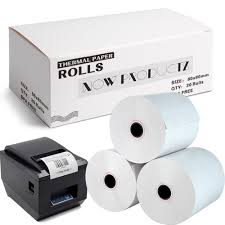Introduction
In today’s fast-paced digital and retail environments, thermal paper plays a vital role in smooth and efficient operations. From printing receipts at supermarkets to producing medical reports and shipping labels, thermal paper ensures clarity, speed, and reliability. The focus keyword thermal paper not only signifies a simple product but also represents a cornerstone of modern printing technology that keeps businesses running seamlessly. This article explores what thermal paper is, how it works, its many advantages, and why it remains a preferred printing medium worldwide.
What is Thermal Paper?
Thermal paper is a specially coated paper that reacts to heat, producing images or text without the use of ink or toner. The surface of the paper contains heat-sensitive chemicals that change color when exposed to a thermal printer’s heated print head.
There are two main types of thermal printing: direct thermal and thermal transfer.
-
Direct thermal printing uses heat-sensitive paper directly to create text or images. It’s widely used in receipts, tickets, and temporary labels.
-
Thermal transfer printing requires a ribbon that transfers ink onto the paper, ideal for long-lasting labels like product barcodes and industrial tags.
Because it eliminates the need for ink cartridges, thermal paper ensures cost efficiency and simplicity, making it a preferred choice for high-volume printing businesses.
How Does Thermal Paper Work?
The magic of thermal paper lies in its multilayer chemical coating, which includes:
-
Base Layer: The foundation paper made from high-quality pulp.
-
Thermal Coating Layer: This layer contains dyes and developers that react to heat and produce the printed image.
-
Protective Layer: Shields the print from moisture, friction, and UV light, extending its readability.
When the printer’s thermal head heats specific areas, the dye reacts and forms the desired text or image. This process is incredibly quick, precise, and quiet — perfect for environments like retail counters, hospitals, and transportation systems.
Key Advantages of Thermal Paper
1. Ink-Free and Low Maintenance
Unlike traditional printers that need ink or toner replacements, thermal printers rely solely on heat. This minimizes running costs and virtually eliminates maintenance issues like ink smudging or nozzle clogging.
2. High-Speed Printing
Thermal printers produce prints in seconds, making them ideal for busy environments such as supermarkets, banks, and ticketing counters. The efficiency of this method supports quick customer service and faster transactions.
3. Excellent Print Clarity
Thermal paper produces sharp, smudge-free images that are easy to read and scan. Whether it’s a barcode, QR code, or text, the print quality remains consistent and professional.
4. Durable and Reliable
The absence of ink means fewer moving parts in the printer, reducing wear and tear. Thermal printers and paper rolls are built for high performance and long-term reliability.
5. Eco-Friendly Options
Modern manufacturers now offer BPA-free, recyclable, and eco-safe thermal papers. These sustainable options ensure minimal environmental impact while maintaining quality performance.
You can also visit to pos software price in pakistan
Popular Uses of Thermal Paper Across Industries
Retail and POS Systems
Thermal paper is a staple in point-of-sale (POS) systems, where speed and precision matter. Retailers, restaurants, and cafes use it to print customer receipts quickly and efficiently.
Banking and Finance
Banks and ATMs use thermal paper for transaction receipts, account statements, and balance slips. Its clarity ensures accurate record-keeping and customer satisfaction.
Healthcare
Hospitals and clinics use thermal paper in devices such as ECG and ultrasound machines. Its fine detailing ensures accurate diagnostic reports.
Transportation and Logistics
Shipping companies rely on thermal paper for labels, tickets, and tracking barcodes, essential for efficient operations.
Entertainment and Hospitality
Movie theaters, event organizers, and hotels use thermal paper for ticket printing, booking confirmations, and vouchers, ensuring smooth and professional service.
Best Practices for Storing Thermal Paper
Thermal paper can fade if not stored properly. To preserve print quality:
-
Keep it in a cool, dry place away from heat and sunlight.
-
Avoid direct contact with plasticizers, oils, and solvents.
-
Store rolls in their original packaging until use.
-
Choose premium thermal paper brands for longer-lasting results.
Proper care ensures receipts, invoices, and records remain legible for several years.
The Future of Thermal Paper
While digitalization continues to grow, the demand for thermal paper remains strong. Many industries still require physical proof of transactions, shipping, and identification. The latest developments in eco-friendly coatings and fade-resistant technology make thermal paper even more sustainable and durable. As technology advances, we can expect smarter, more energy-efficient thermal printers that complement digital workflows without replacing the need for physical documents entirely.
Conclusion
Thermal paper continues to be an unsung hero in modern business operations. Its inkless printing technology, low maintenance, and high-speed performance make it indispensable across industries. From retail receipts to medical reports and logistics labels, thermal paper ensures reliability, accuracy, and quality. With innovations focusing on eco-friendly production and enhanced durability, thermal paper will remain a key printing material for years to come.
For further articles visit here






0 Comments